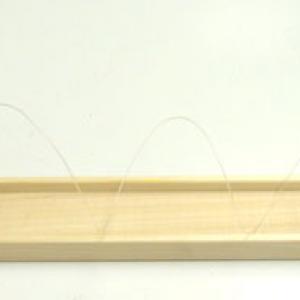College of Liberal Arts & Sciences
1D10.11 - Vector Toys
Place the toys on a flat surface and hand the attached weight over the edge of the table. Try to make sure that the weight is not swinging when you start the toy. The toy should walk towards the end of the table and stop at the edge when the vector (string and weight) points straight down.
The large wooden walker is made for walking down an inclined ramp. However, with a mass of 20 grams on the end of the string, it will walk on a level surface. It is best if it still walks on the ramp ( not inclined ) or a rough table top, as the walker will slide on a smooth table top.
- Heidi Strahm Black, "Vector Toy", TPT, Vol. 36, # 6, Sept. 1998, p. 375
- Thomas J. Parmley, J. Irvin Swigart and Ray L. Doran, "Lecture Demonstrations for the High School Science Teacher", TPT, Vol. 4, # 1, Jan. 1966, p. 36.
- "Problems That Bother Me", TPT, Vol. 4, # 3, March 1966, p. 144.
- Jodi and Roy McCullough, "Vectors with Walkers", The Role of Toys in Teaching Physics", p. 4.16.
- Jodi and Roy McCullough, "Vectors with Wind-up Toys", The Role of Toys in Teaching Physics", p. 4.14.
Disclaimer: These demonstrations are provided only for illustrative use by persons affiliated with The University of Iowa and only under the direction of a trained instructor or physicist. The University of Iowa is not responsible for demonstrations performed by those using their own equipment or who choose to use this reference material for their own purpose. The demonstrations included here are within the public domain and can be found in materials contained in libraries, bookstores, and through electronic sources. Performing all or any portion of any of these demonstrations, with or without revisions not depicted here entails inherent risks. These risks include, without limitation, bodily injury (and possibly death), including risks to health that may be temporary or permanent and that may exacerbate a pre-existing medical condition; and property loss or damage. Anyone performing any part of these demonstrations, even with revisions, knowingly and voluntarily assumes all risks associated with them.


